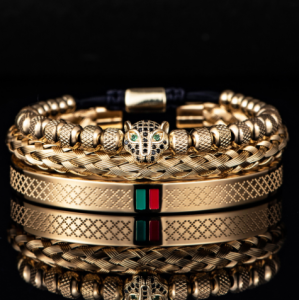Jewelry has been a staple in fashion and personal adornment for centuries, evolving in materials, styles, and functions. Two prominent categories in today’s jewelry market are stainless steel jewelry and ordinary jewelry, each offering distinct features and advantages. Understanding their differences and uses can help consumers make informed choices based on their needs and preferences.
Material Composition and Durability
- Stainless Steel Jewelry
Stainless steel jewelry is crafted from an alloy containing iron, chromium, nickel, and carbon. The addition of chromium gives stainless steel its signature resistance to rust, tarnish, and corrosion. This durability makes it an excellent choice for everyday wear, especially for those exposed to moisture or harsh environments. Additionally, stainless steel is hypoallergenic, making it suitable for people with sensitive skin or metal allergies. - Ordinary Jewelry
Ordinary jewelry typically refers to pieces made from a variety of materials, including base metals (such as brass or copper), precious metals (like gold, silver, or platinum), and even non-metal components like wood, plastic, or fabric. While precious metals offer luxury and prestige, base metals are more affordable but can tarnish, corrode, or cause skin irritation over time. Non-metal materials, though diverse in style, lack the longevity of metal-based jewelry. 
Aesthetic and Design Flexibility
- Stainless Steel Jewelry
Stainless steel is a versatile material, allowing for sleek and modern designs. Its polished, silvery finish mimics the look of white gold or platinum at a fraction of the cost. Designers can experiment with textures, engravings, and even color plating, such as gold or black, to create unique pieces. However, stainless steel is harder to mold into intricate designs compared to softer metals like gold or silver. - Ordinary Jewelry
The term “ordinary jewelry” encompasses a broader spectrum of aesthetics. Precious metals like gold and silver are prized for their malleability, allowing intricate detailing and sophisticated designs. Non-metal jewelry materials further expand the creative possibilities, enabling bold and unconventional styles that appeal to diverse fashion tastes. 
Price and Accessibility
- Stainless Steel Jewelry
One of the most significant advantages of stainless steel jewelry is its affordability. It offers the look and durability of high-end materials without the hefty price tag, making it accessible to a wider audience. This affordability also allows consumers to experiment with different styles without breaking the bank. - Ordinary Jewelry
The cost of ordinary jewelry varies widely based on the materials used. Precious metal jewelry, especially with gemstones, commands higher prices due to the value of the materials and craftsmanship. In contrast, costume or fashion jewelry made from base metals or synthetic materials is budget-friendly but may lack longevity. 
Uses and Occasions
- Stainless Steel Jewelry
Stainless steel jewelry is ideal for casual and everyday wear due to its durability and resistance to wear and tear. It is particularly popular in men’s accessories like watches, chains, and bracelets, as well as minimalist and unisex designs. Its hypoallergenic properties make it a go-to option for body piercings. - Ordinary Jewelry
Ordinary jewelry caters to a wide range of occasions. Precious metal pieces are often reserved for formal events, weddings, and as heirlooms due to their elegance and intrinsic value. Costume jewelry, on the other hand, is perfect for trendy, short-term use, allowing wearers to match their accessories to specific outfits or themes without significant investment. 
Maintenance
- Stainless Steel Jewelry
Low maintenance is a hallmark of stainless steel jewelry. It requires only occasional cleaning with soap and water to maintain its shine. Unlike silver, it does not tarnish, and its resistance to scratches ensures it stays looking new for years. - Ordinary Jewelry
Maintenance needs vary greatly for ordinary jewelry. Precious metals like gold and silver require regular polishing to prevent tarnish. Costume jewelry, especially those made from base metals, may discolor or degrade quickly if not stored and cared for properly. 
Conclusion
Stainless steel jewelry and ordinary jewelry each have their unique strengths, making them suitable for different preferences and uses. Stainless steel shines as a durable, affordable, and low-maintenance option for everyday wear, while ordinary jewelry offers unparalleled variety and prestige, particularly in precious metals. By understanding these differences, consumers can select the type of jewelry that best fits their lifestyle, budget, and occasion. Whether opting for the practicality of stainless steel or the luxury of traditional materials, jewelry remains a timeless way to express personal style.
Categories
Recent Posts
Recent Comments
- How Foreign Businessmen Buy Goods in Yiwu Market – Bairuida Trading – Yiwu Market Agent on Yiwu International Trade City / Market / Mart
- How to Import Small Amounts of Goods from China: A Guide to Starting a Business – Bairuida Trading – Yiwu Market Agent on Trading Companies or Manufacturers: Who Should You Choose?




Recent Comments